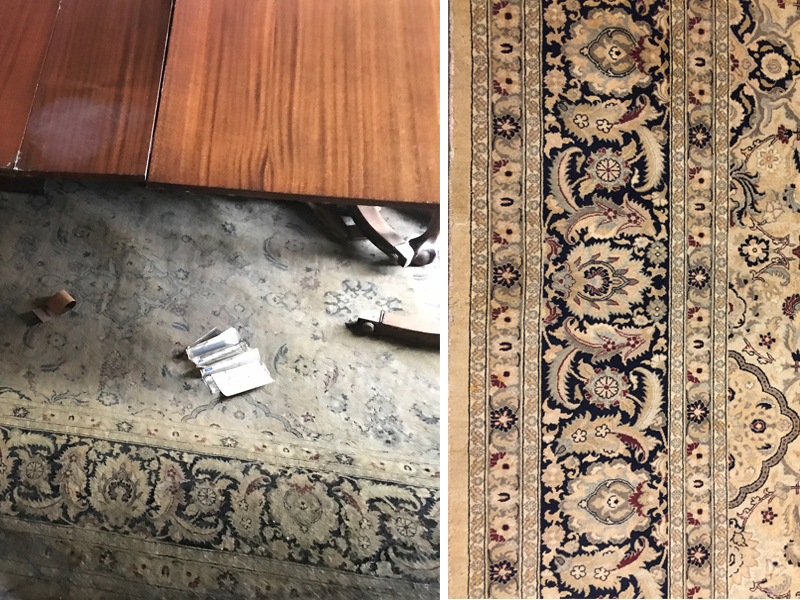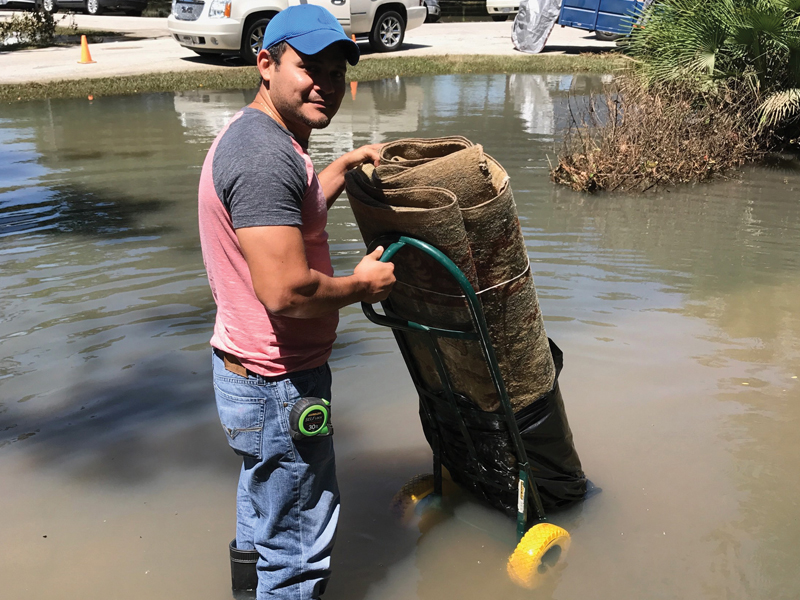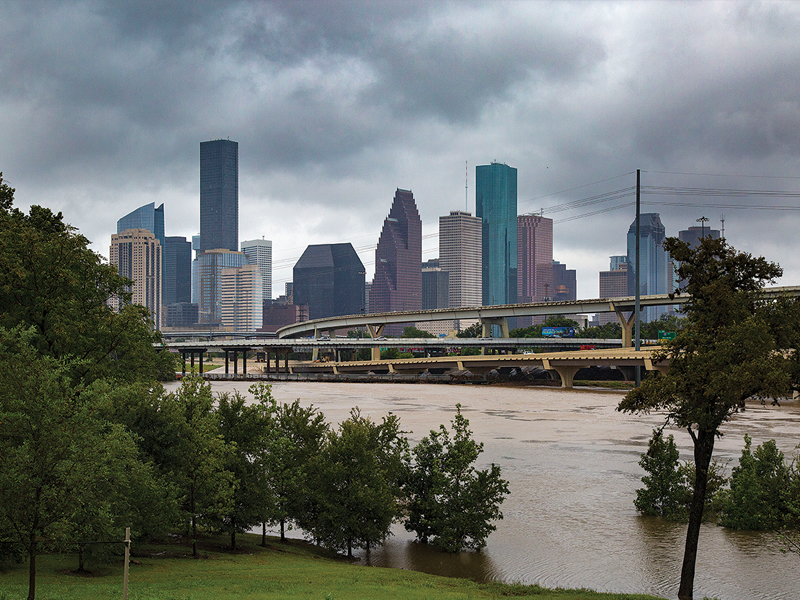In late August 2017 a calamitous hurricane caused massive flooding and destruction in Houston, Texas. As the city and region continues to rebuild, rug insider Lisa Slappey of Pride of Persia Rug Company & Postmodern Traditions provides a narrative on the fate of deluged rugs and carpets and the state of rug sales.
By the time we closed our rug showroom at 6:00 p.m. on Saturday, August 26, 2017, Houston had already begun to shut down in anticipation of heavy rainfall from Hurricane Harvey, which had slammed into the Texas coast almost 200 miles southwest in Rockport the night before as a Category 4. Every forecast warned that the storm would stall, causing catastrophic flooding in Houston. They were right. Inching east along the Gulf Coast, Harvey dropped up to fifty inches of rain and left more than half a million vehicles destroyed, nearly 300,000 homes damaged, and sixty-eight people dead. Damage estimates topped $125 billion. From the microcosmic view of a rug insider, the destructive power of this storm was astonishing.
Those of us in the rug industry understand that rugs and water have a complex relationship. Professional cleaning is part of maintenance, but that doesn’t mean the rug enjoys the process. Bad things tend to happen when a rug gets wet outside the confines of expert cleaning. Moisture from a potted plant, a burst pipe, or even a glass of water on certain rugs can prove quite damaging.. A flood, though, is disastrous. Now imagine the United States’ fourth-largest city submerged. Imagine all of those waterlogged rugs. During the Hurricane Harvey Flood (yes, we have so many floods that we name them here), Houston received the most rainfall ever recorded in a single event in the United States. The rain fell in torrents that Saturday night, rising in the streets, overtopping the banks of bayous, flooding cars and businesses and homes throughout the metro area. Local news stations stayed on air, except for the one that flooded, for days on end, broadcasting the devastation in real time. When the storm indeed stalled, training bands of rain gathered fuel from the ever-warming Gulf of Mexico.
The first rug cleaning call came to my cell phone early that Sunday morning from an elderly couple whose antique Bijar was under water in their sunken living room. Daybreak revealed the opening salvo of that ceaseless rainfall: residents trapped in their homes awaited rescue by boat or helicopter. Though my home and the shop were spared, my partner’s home flooded, and I could hear the helicopter overhead each time we spoke. Known historically as the Bayou City, Houston reverted to its past as roads became rivers and watersheds our dividing lines. I knew I would be trapped on one side or the other of Buffalo Bayou, the flowing heart of Houston, with no route between showroom and home. I tested the boundaries of my dry street only to find neighbors launching kayaks to bring friends from their flooded homes. Many of those friends and neighbors are also my clients, and Buffalo Bayou was coursing through their living rooms and dining rooms. My mental map showed sodden rugs in familiar homes.

Several feet of flood water submerged this Pakistani Tabriz in the dam-release area of Houston’s Energy Corridor. Right: The same rug revived after an initial cleaning. Secondary treatments to address areas of concern—such as rust or furniture marks—come after the initial cleaning once the carpet is further assessed.
A second tragic chapter unfolded overnight when entire neighborhoods unscathed by the rainfall flood became victims of intentional “controlled” dam releases executed by the U.S. Army Corps of Engineers in an effort to mitigate reservoir flooding and to prevent the catastrophic failure of our aging earthen dams. By 2:00 a.m. Monday, Houstonians who had never flooded suddenly had several feet of water in their homes. Mature people of means who had lived in their homes for decades suddenly found themselves homeless, escaping by boat with whatever possessions they could carry in garbage bags. Once the water had receded enough for our team to navigate routes to the shop, we started tracking down extra pairs of rubber boots and gloves, respirator masks, and unfathomable quantities of anti-bacterials. All of our phone lines forwarded to my cell phone, which became our dispatch center. It rang non-stop. Shortly after sunrise Wednesday, our vans were on the road to pick up wet rugs, my notebook a cartographic mess of trips grouped by street address. This was an all hands on deck crisis not just for us, but for every rug cleaner in town. Everyone from our shop was either picking up rugs or washing them, leaving me to handle the phones and paperwork. Soon, clients started bringing in rugs on their own. We hired extra help, expanded our washing facility, and made it a 24-hour concern, with someone always present to care for the rugs. Our mission shifted immediately from primarily sales to almost exclusively service. As Houstonians united to help one another, we at Pride of Persia Rug Co. did our best to save rugs. This meant a great deal to people who had lost almost everything else.
We found rugs in every condition imaginable. Some had been elevated onto furniture or carried upstairs. Their owners simply wanted them cleaned before going back on the floor, assuming they still had a floor. Most, though, were in a state of disrepair. Color run and fiber loss became minor considerations compared to health concerns. The first order was triage—determining what could be saved—followed by initial cleaning to remove the floodwater. The detail work, and seemingly interminable paperwork for insurance companies or FEMA, would come later.
At the easier appointments, our team retrieved rugs from clients’ backyards and driveways, already hosed down or soaked by recurrent rainfall then baked in the sun, the wool crunchy with debris. The more difficult cases involved extracting rugs from under furniture, sheetrock, and layers of fetid sludge. People in the Memorial and Energy Corridor neighborhoods inundated by the dam releases called to say, “We’ll have four feet of water in the house for two weeks. Can you save our rugs?” We told them we would do our best and put them on the schedule for pick up as soon as the water receded.
There were, of course, unscrupulous types ranging these wealthy areas, telling homeowners they would haul away and dispose of their “ruined” rugs for free. Some of our shell-shocked clients lost their larger Persian rugs because hasty contractors cut them up just to get them out of the house so they could begin demolition.

Pride of Persia Rug Company’s staff shown wading through water to rescue rugs in Houston's Memorial area ten days post-Harvey.
Which rugs fared best? Among the non-Persians, Karastan rugs tended to hold up well, as did Peshawars and Magnolia rugs. Older Persian rugs, including survivors of previous floods, were generally salvageable. The focus on these was removing contaminants and odor. Newer pieces, however, especially those with high silk content, typically had such fugitive dyes that the best we could do was remove the excess color. Older Oushaks and rugs with previous repair proved more challenging, as the flood waters compromised already weakened pieces. Latex? Not worth cleaning. Transference was a significant problem. Even a relatively short exposure to water could result in staining from other materials, such as rust from metal furniture or discoloration from wood.
We heard from people outside of Houston that the market should explode as soon as the flood ended. This has proven to be a false expectation. For two months following Harvey, rug sales ground to a halt. Our strongest selling season is the fall, beginning the week public school resumes. Classes were to have started on August 28th. The first schools opened on September 11th, with others following on a rolling schedule as they became safe to occupy. We were still picking up rugs for cleaning as the season ticked away. Once the rugs were cleaned, clients had no place to use them, so they went to our warehouse for storage.
The flood’s economic impact has been severe. Insurance companies and mortgage companies have been slow to pay policyholders, and FEMA covers only a portion of losses. The majority of flood victims did not have flood insurance. They were not required to do so because they did not live in federally designated 100-year floodplains. Those designations are irrelevant marks on maps when it rains in Houston.
The psychological impact of the flood kept even those whose homes remained dry from focusing on material things. Consumers view rugs, especially in the handwoven and custom sectors, as luxury goods. Flood victims have to consider what to do next, and purchasing beautiful rugs is far down the list of priorities. Should they rebuild their homes? Move to higher ground or even to high-rises? Downsize? Walk away? A wave of foreclosures on unliveable houses is imminent.
Cleaning rugs kept us afloat during the worst disaster in Houston’s history, but that disaster has yet to end. Six months after the storm, individual clients and restoration companies are still bringing us rugs to clean. We’re picking glass out of Ghaznis from Rockport and pulling rugs from garages in Meyerland. Although a few clients each week are moving back into their rebuilt homes—or into new places altogether —most are far from ready for rugs on the floor. Our warehouse remains packed with pieces awaiting return. The thought that all of these flood victims will want to buy rugs is a lovely fantasy. Recovery from this storm will take years. Some of our customers flooded three times in twenty-seven months. After the Memorial Day Flood in 2015, the Tax Day Flood in 2016, and the Hurricane Harvey Flood in 2017, weary clients are suffering from economic and psychological uncertainty. Thanks to rapacious development combined with climate change, Houstonians are likely to endure another flood before cleaning up from this one.
Photography: Image of Buffalo Bayou with downtown Houston in the background courtesy of Don Hoffman. Image of Karastan rug courtesy of Karastan. All other images courtesy of Lisa Slappey.
